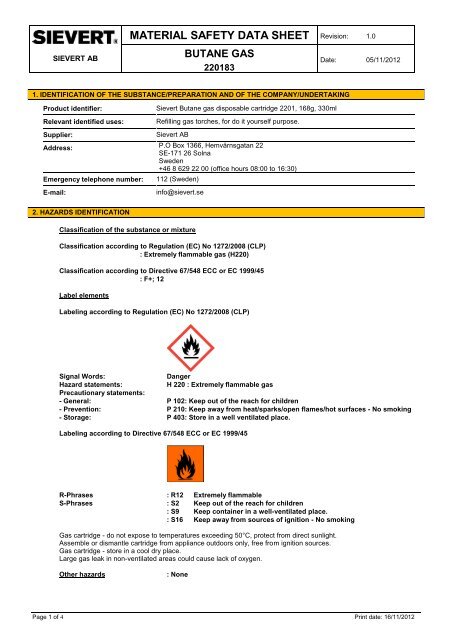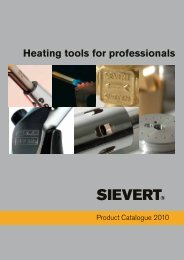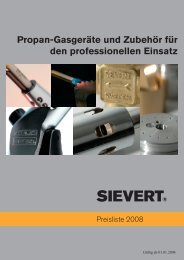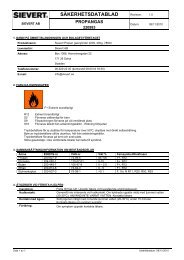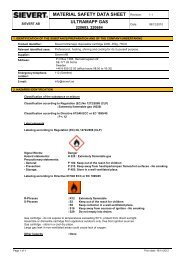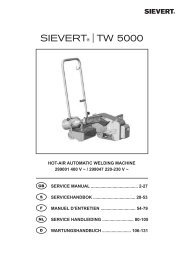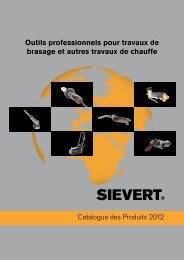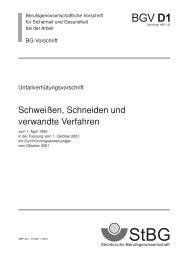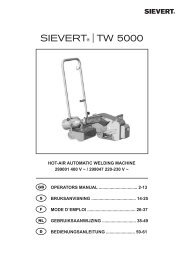Pdf (34kB) - Sievert AB
Pdf (34kB) - Sievert AB
Pdf (34kB) - Sievert AB
- No tags were found...
Create successful ePaper yourself
Turn your PDF publications into a flip-book with our unique Google optimized e-Paper software.
SIEVERT <strong>AB</strong>MATERIAL SAFETY DATA SHEET Revision: 1.0BUTANE GAS220183Date: 05/11/20121. IDENTIFICATION OF THE SUBSTANCE/PREPARATION AND OF THE COMPANY/UNDERTAKINGProduct identifier:Relevant identified uses:Supplier:<strong>Sievert</strong> Butane gas disposable cartridge 2201, 168g, 330mlRefilling gas torches, for do it yourself purpose.<strong>Sievert</strong> <strong>AB</strong>Address: P.O Box 1366, Hemvärnsgatan 22SE-171 26 SolnaSweden+46 8 629 22 00 (office hours 08:00 to 16:30)Emergency telephone number:E-mail:112 (Sweden)info@sievert.se2. HAZARDS IDENTIFICATIONClassification of the substance or mixtureClassification according to Regulation (EC) No 1272/2008 (CLP): Extremely flammable gas (H220)Classification according to Directive 67/548 ECC or EC 1999/45: F+; 12Label elementsLabeling according to Regulation (EC) No 1272/2008 (CLP)Signal Words:DangerHazard statements:H 220 : Extremely flammable gasPrecautionary statements:- General: P 102: Keep out of the reach for children- Prevention: P 210: Keep away from heat/sparks/open flames/hot surfaces - No smoking- Storage: P 403: Store in a well ventilated place.Labeling according to Directive 67/548 ECC or EC 1999/45R-Phrases : R12 Extremely flammableS-Phrases : S2 Keep out of the reach for children: S9 Keep container in a well-ventilated place.: S16 Keep away from sources of ignition - No smokingGas cartridge - do not expose to temperatures exceeding 50°C, protect from direct sunlight.Assemble or dismantle cartridge from appliance outdoors only, free from ignition sources.Gas cartridge - store in a cool dry place.Large gas leak in non-ventilated areas could cause lack of oxygen.Other hazards: NonePage 1 of 4 Print date: 16/11/2012
SIEVERT <strong>AB</strong>MATERIAL SAFETY DATA SHEET Revision: 1.0BUTANE GAS220183Date: 05/11/20128. EXPOSURE CONTROLSAppropriate engineeringcontrols:Personal protectionequipment:Environmental exposurecontrols:No further data, see item 7.Make sure that it is well ventilation. Do not smoke during handling.No further data, see item 7.9. PHYSICAL AND CHEMICAL PROPERTIESForm: Liquefied gas. Vapour pressure:Approx. 345 kPa (absolute) at20°CColour: Colourless. Gas density: heavier than air.Odour:Density:Grammoleculemass:Upper explosionrisk limit::Lower explosionrisk limit:Boiling point:Naturally odourless, after odorizationa strong, unpleasant characteristicsmell.Approx. 575 kg/m3 at 15°C.approx. 58.12 g/mol.Approx. 8.5% (V/V).Approx. 1.8% (V/V).Approx. -1°C.Grammoleculemass:Spontaneouscombustion temp.:Explosivecharacteristics:n-Octanol/waterpartitioncoefficient:Solubility inwater/grease:approx. 58.12 g/mol.365°CIn use, it can form aflammable vapour/air mixture.Log/Pow 2.8 (estimatedvalue).Insoluble10. ST<strong>AB</strong>ILITY AND REACTIVITYPossibility of hazardousreactions:Conditions to beavoided:Hazardousdecomposition products:No decomposition if used according to specifications.No dangerous reactions known.No dangerous decomposition products known.11. TOXICOLOGICAL INFORMATIONInformation on toxicological effectsRisks at inhalation:Risks at contact:Propane/butane is a gas slightly narcotic and may in highly concentrated form irritatemucous membranes and cause suffocation. The suffocation effect is proportional to thedecrease of the partial pressure of the oxygen in the inhalation air obtained at a mixtureof propane/butane and air. When the oxygen content has decreased to three fourths orless of the normal content asphyxia occurs. The body interprets this as a lack of oxygenand reacts (at concentrations of 50 vol.-% propane/butane in air) with pronouncedsymptoms of suffocation in the form of difficulty to breath and hyperventilationsimultaneously with deteriorated reaction ability and impaired muscle co-ordination. Moreserious cases (at concentrations of 75 vol.-% propane/butane in air) may end inunconsciousness and death.Propane/butane in liquefied or gaseous form may cause serious frostbites on skin oreyes. If propane/butane in liquefied form gets into contact with objects of a highertemperature than the liquid itself it results in fierce boiling and splashing.Page 3 of 4 Print date: 16/11/2012
MATERIAL SAFETY DATA SHEET Revision: 1.0SIEVERT <strong>AB</strong>BUTANE GAS220183Date: 05/11/201212. ECOLOGICAL INFORMATIONEcological informationGeneral note:Generally not hazardous for water.13. DISPOSICAL CONSIDERATIONSWaste treatment methodsRecommendation:Must not be disposed together with household garbage. Do not allow product to reachsewage system. Product to be deposited at suitable recirculation place, according toofficial regulations.EWC code: 16 05 05. Gases in pressure containers other than those mentioned in 16 05 04.14. TRANSPORT INFORMATIONUN-Number: 1950ADR, IMDG, IATA labelingLand transport ADR / RID (Car and Train)Class: 2Classification code:5FLabel: 2.1Description of goods:1950 AEROSOLS flammable, LQMarin transport IMDGClass: 2Marine pollutant:Proper shipping name:No1950 AEROSOLS flammable, LQAir transport ICAO / IATAClass: 2Label: 2.1Proper shipping name:1950 AEROSOLS flammable, LQ15. REGULATORY INFORMATIONSafety health and environmentalregulations/legislation specificfor the substance or mixture:Make sure that all national and local regulations are followed.16.OTHER INFORMATIONThis information gives the health, safety and environmental aspects of the product based on current knowledge.The information given above is based on our current knowledge of this product. The purpose of this information is todescribe the product in the light of the requirements imposed with regard to health, safety and the environment inaccordance with 67/548/EEG, 1999/45/EG, 76/769/EEG and 1272/2008 (CLP)End of documentPage 4 of 4 Print date: 16/11/2012


